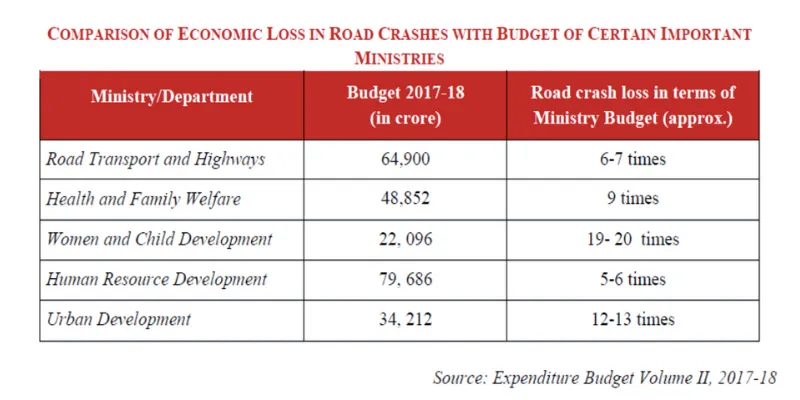Road to recovery: What needs to be done to cut down on road accidents and ensure a safer India?
With road accidents being termed as a national emergency, a strong multi-sectoral approach, combined with legal reforms, long term policy vision, local innovation along with an industrial scale intervention is required to solve road safety issues.

Danish Zehen (22) was an upcoming entrepreneur, full of life. With over one million followers on social media, he had become quite an internet sensation among youth across the country. He had big dreams for himself and had recently purchased a new home for his parents.
On December 20, 2018, while on his way back from a friend’s wedding, his life was snuffed out by a road crash on the Sion-Panvel Highway, not too far from his new home in Navi Mumbai. Danish’s brother Shahzad was also critically injured in the accident, and he may never be able to fully recover from his injuries.
Danish had grown up in a chawl and his meteoric rise was synonymous with India’s own growth story, with young entrepreneurs making a mark for themselves and driving the economic engine. And his death too is now synonymous with the pandemic that road crashes have become for young people in India.
As per the latest reports from the Government of India and the World Health Organization (WHO), road crashes are the number one cause of death for people in the age group of five to 29 years in India. This means that the most productive age-group in our country, the catalyst of our economy composed of countless Danish’s, is getting wiped out by a violent but an entirely preventable cause of death.
It is not surprising, therefore, that the annual economic loss suffered by India due to lost productivity, combined with the forced burden on our police, courts, healthcare, and insurance systems, amounts to a monumental three percent of our GDP or Rs 4.3 lakh crore every year. That’s enough to fund Prime Minister’s Swachh Bharat Abhiyan twenty-seven times over each year or underwrite the entire Budget for several key ministries of the Government of India.

The question you may ask then is - Why is this issue not a top priority for our government and citizens? After all, anything that kills over 400 people each day surely qualifies as an emergency.
The Supreme Court of India has indeed called road crashes a “National Emergency”, directing the government to take urgent measures to control the menace. The government, both at the Union and State level, has initiated some action, but the alacrity and political-will that a mass killer of this proportion deserves, is visibly missing.
In comparison, other forms of violent injury such as terrorism or war are the top priorities, and deservedly so. But here’s a quick analysis of the gravity of the problem. Between 1988 and 2015, close to 44,000 people have been killed in terrorist violence in India, and the number of road accident fatalities in 2015 alone was more than three times this number.
In the five wars that independent India has witnessed, the number of people killed is 10,253. The annual figure alone for road crash deaths in India is fifteen times this number.

Also Read: Safety first – how these startups are ensuring you reach home safe
As if these government statistics were not alarming enough, WHO’s Global Status Report on Road Safety 2018 suggests that the actual road traffic fatality figures may be double the number reported by the Ministry of Road, Transport and Highways at 2,99,091 deaths in 2017.
Innovative solutions required
In order to bring down the number of deaths and injury count due to road accidents, a strong multisectoral approach is required. In addition to legal reforms and a long-term policy vision for road safety in India, the government, industry and non-governmental institutions must focus on capacity building, including the application of technology, to take on the problem at scale.
For instance, SaveLIFE Foundation, in partnership with the Government of Maharashtra and Mahindra & Mahindra, is implementing various new solutions on the Mumbai-Pune Expressway to reduce road crash deaths on the high-speed corridor.
It is also critical to enhance research capacity and quality. The best practices and technologies being used in high-income countries may not fit well with the safety requirements of low- and middle-income countries. Hence, there needs to be local innovation to solve some of our unique problems.
For example, in the financial year 2015-16, India imported $33.11 million worth of Child Restraint Systems (CRS) and Booster seats. Such expensive imports, in the absence of competition from local manufacturers, invariably raises the selling price of these goods, thereby affecting the demand and keeping such crucial devices out of reach of the masses. A thorough understanding of the user groups and the capacity of the industries that could potentially manufacture CRS would aid in domestic manufacturing and also bring down the cost, thereby increasing the usage of this safety device.
Also Read: Ola sets up ‘Safety Council’ for road safety in India
Similarly, smart enforcement systems must be developed to prevent crashes and enforce laws more efficiently by eliminating the chances of lags, human error or corruption. Such systems could include Intelligent Highway Management System that will have the capacity to capture traffic rule violation electronically.
A centralised and digitised registration and licensing processes can eliminate the chances of one person holding multiple licences, and a comprehensive record of vehicles registered and licences given out will also lead to more effective identification and apprehension of traffic violators. These would also reduce the issue of under-reporting of traffic transgressions and crash incidents.
The traffic police, who are the first responders at the site of a road crash, should be able to determine the “how”, “what” and “why” of the crash. The police officer must be able to not only capture the legalities of a road crash investigation, but also the science of it.
To bring down the number of road crashes and injuries, it is pertinent to identify the factors influencing such crash and injuries. Crash Investigation is the only method to identify the causal and contributing factors (human/vehicle/infrastructure risk factors) influencing the crash and the resulting injuries, and there’s a huge need for technology and training in this space.
Also Read: Road safety starts with you and me
There is also a need to have innovative health system solutions. For example, a trauma registry to electronically capture information about the nature of injuries, outcomes, and details regarding care delivered to patients in hospitals can be used not just to improve the efficiency and quality of trauma care, but also determine preventive measures across vehicle technology, infrastructure and human behaviour.
Entrepreneurial approach to road safety
For many years, the Indian government has been carrying out awareness campaigns and road safety workshops in schools, colleges and workplaces. However, these campaigns have not been able to bring about a change in behaviour and reduce the number of deaths and injuries suffered due to road crashes.
Hence, the magnitude of the problem clearly requires an industrial scale intervention. And the only way to do that is to encourage an industry to develop around it. All the technologies and solutions aforementioned need to be built locally and made available to masses at affordable prices.
This will enable linkages with educational institutions who will begin imparting lessons on solving the problem so that students can graduate and go on to work in the area of road safety. The government can also incentivise the creation of such a sector, given the massive loss to GDP we suffer each year.
For instance, when the current government came into power in 2014, it changed the name of the Ministry of Environment and Forest (MoEF) to Ministry of Environment, Forests and Climate Change (MoEFCC). The change might seem tokenistic but it wasn’t. It helped in not only acknowledging the issue of climate change but also spurred the growth of innovation in the sector with many social entrepreneurs jumping in to address the problem.
Whether changing the name of Ministry of Road Transport and Highways (MoRTH) to Ministry of Road Safety Transport and Highways (MoRSTH) will bring about the desired change will only be known once it happens, but there is no denying that the spirit of enterprise in our youth today, as with Danish, combined with decisive policy action is the only way to save lives on our roads.
This article was a part of the Road Safety Week series, where SocialStory discussed the multiple interventions required to make the Indian roads safer for the citizens.







